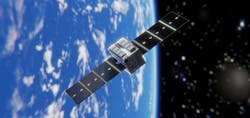ADELAIDE, Australia - Fleet Space Technologies in Adelaide, Australia announced the successful deployment of its next-generation Centauri-6 satellite on SpaceX's Bandwagon-1 mission, launched aboard a SpaceX Falcon 9 from Launch Complex 39A at the Kennedy Space Center in Florida. The Centauri-6's technology will be part of the company's end-to-end mineral exploration solution, ExoSphere, while also building capacity to deliver advanced satellite communications capabilities with microsatellite architectures.
Centauri-6 has been designed with multiple upgrades to enhance the overall capacity of Fleet Space's low-Earth orbit (LEO) satellite constellation to support the growing demand for its end-to-end mineral exploration technology, ExoSphere. The satellite has been designed with an ion electric propulsion system powered by solar panels to provide thrust in the vacuum of space. Centauri-6's design also leverages 3D-printed components - including the 3D-printed metal patch antenna Fleet Space pioneered on earlier Centauri satellites.
ExoSphere, Fleet Space's flagship mineral exploration technology, combines the latest advances in satellite connectivity, edge computing, AI, and geophysics to deliver 3D subsurface models of a survey area in days with near-zero environmental impact. To generate the 3D models, Fleet Space's satellite-enabled seismic sensors - called Geodes - are distributed into an array across a survey area, then the data is transmitted and processed by Fleet Space's satellite constellation in LEO, providing near real-time access to survey results for exploration customers around the world. Traditionally, seismic data acquisition and processing has taken months or years before it can be used as part of an exploration campaign.
Related: Fleet Space selects Firefly to deliver payload to the far side of the Moon
Recently, Fleet Space's Centauri-4 became the world's smallest voice-enabled satellite after a demonstration of Push-To-Talk (PTT) capabilities to the Australian Defence Force Joint Capabilities Division as part of their ASCEND2LEO program. Fleet Space's SPIDER seismic technology will also head to the Moon to search for water ice and deliver new insights about the lunar regolith on Firefly Aerospace's second lunar mission in 2026 as part of a NASA CLPS initiative.



